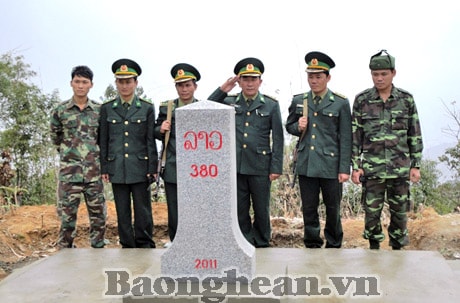Historical marks of Vietnam - Laos border marker planting work
(Baonghean.vn) -The border between the Socialist Republic of Vietnam and the Lao People's Democratic Republic is about 2,067km long, stretching across 10 provinces of Vietnam: Dien Bien, Son La, Thanh Hoa, Nghe An, Ha Tinh, Quang Binh, Quang Tri, Thua Thien - Hue, Quang Nam and Kon Tum; bordering 10 provinces of Laos: Phongsaly, Luang Prabang, Huaphan, Xieng Khouang, Bolikhamxay, Khammouane, Savannakhet, Salavan, Sekong and Attapeu.
Most of the border between the two countries passes over mountain peaks or slopes and through dense forests; the lowest point is about 300m and the highest point is over 2,700m above sea level. Some passes have become border gates connecting the two countries, while other border sections are mostly rugged mountains, making travel difficult. The population living on both sides of the border is mostly ethnic minorities, living sparsely in villages far from each other and far from the border.
Since the French colonial period, the border between Vietnam and Laos was determined by Decrees of the Governor-General of Indochina.
On July 18, 1977, the National Border Demarcation Treaty between the Socialist Republic of Vietnam and the Lao People's Democratic Republic was signed by representatives of the two states in the capital Vientiane (Laos), marking an important step in the process of building the Vietnam - Laos border into a border of peace, friendship, stability and long-term cooperation and development.
In 1978, the two sides began to demarcate and mark the entire Vietnam-Laos border and completed this work in 1987. After basically completing the demarcation and marking work in the field in 1987, the two sides signed the Agreement on Border Regulations on March 1, 1990 and the Supplementary Protocol to the Agreement on Border Regulations on August 31, 1997 to create a full legal basis for border protection and management between the two countries.

Inauguration of milestone 405 at Nam Can border gate (Ky Son, Nghe An), the first milestone completed in the Plan between Nghe An and provinces sharing the border
Nghe An Border Guard force salutes the newly completed Vietnam-Laos border marker No. 380.
However, the system of national border markers completed in 1987 was built during a period when both countries were still facing many difficulties, the economy was not yet developed, and technology was limited, so it did not meet the requirements of a unified marker system, ensuring long-term stability. Moreover, the marker density was too sparse, on average over 10 km per marker (in some places the distance was over 40 km). Therefore, the actual border line in some places was unclear, so the management force and people on both sides of the border did not clearly recognize the border line.
The design and construction of the markers are not suitable for the terrain, geology, and climate conditions in the border area, as well as their small size and low quality, so most of the markers have degraded and damaged. Most of the markers have had to have their foundations reinforced; some markers have had to be repaired many times, which is costly but does not ensure stability. In recent years, the two sides have opened and upgraded many border gates, along with newly built, spacious, and modern works. Many residential areas near the border have developed strongly, so the old marker system is no longer suitable, and does not clearly show the border line in the field, especially at border gates, where there are many people passing by, causing difficulties for border management.
Based on the above reality, in order to serve the need for long-term stable border management coordination, contributing to the sustainable consolidation of the special relationship between Vietnam and Laos, in May 2008, Vietnam and Laos officially implemented the Master Plan for the implementation of the work of increasing the thickness and embellishing the Vietnam - Laos border marker system with the aim of perfecting the border marker system between the two countries in the direction of accuracy, modernity, sustainability and unity along the entire border. According to the Plan, the total number of increased and embellished markers includes 792 markers/826 markers along the entire border (some marker positions are double markers, triple markers) with 16 large markers, 190 medium markers, 586 small markers; including 3 types of markers: large markers placed at border gates, medium markers placed at embellished locations, small markers placed at thickened locations. All milestones are crafted from solid granite, with modern design, ensuring sustainability and meeting criteria in accordance with international practices.
To complete the schedule of increasing the density and upgrading the Vietnam - Laos border marker system in the field according to the plan set out by the two governments, 19 Vietnamese marker planting teams (Nghe An province has 2 teams) and 16 Lao marker planting teams had to overcome numerous difficulties, with high determination to complete the task. The terrain of the Vietnam - Laos border area is extremely rugged, divided by rivers and streams, and inconvenient transportation, making it very difficult to deploy vehicles, technical equipment and mobilize human resources. In some places, the marker location is on a mountain peak over 2,700m above sea level, to get there, one has to climb mountains and wade through streams for 6 - 7 days through the forest. At many marker locations, the marker planting teams had to open kilometers of public roads to transport materials and markers for construction. Materials for building markers were not available on site and had to be transported many stages, dozens of kilometers of forest and mountain roads away from the marker location.
In addition, officers, employees, soldiers, and workers working on the border always have to face harsh weather, storms, flash floods, epidemics, wild animals, etc. Not to mention tons of bombs, mines, and explosives left over from the war that directly threaten the lives of those participating in the border marker planting. In particular, in some border areas, our and our friends' border marker planting teams are also threatened by reactionary exiles in Laos, inciting bad elements to obstruct their work. The Steering Committee for the border marker planting in localities sharing the border has promptly coordinated closely with the functional agencies of the two countries to develop plans to ensure absolute safety for the border marker planting delegations, while strengthening the dissemination and propaganda to each border resident about the Party's guidelines and policies, the policies of the two States of Vietnam and Laos on the work of increasing and embellishing the border marker system, mobilizing people to strictly comply with the National Border Regulations... Therefore, each completed border marker is the result of a process of extremely difficult and arduous labor and fighting, not only "sweat and tears", but also the blood of the forces participating in the marker planting.
According to the Vietnam - Laos Joint Committee for Border Marker Planting, the work of planting border markers between Vietnam and Laos in the field was basically completed by the end of June 2013. On July 9, 2013, the two governments will hold a ceremony to celebrate and cut the ribbon to inaugurate the 460th border marker at Thanh Thuy border gate (Nghe An, Vietnam) and Nam On (Bo-Ly-Kham-Xay, Laos), marking the completion of the work of planting markers in the field along the entire Vietnam - Laos border. This is an extremely important event, contributing to building a peaceful, friendly, stable, cooperative and mutually developing border, creating favorable conditions for promoting socio-economic development in the border area in particular and economic development of Vietnam - Laos in general.
Le Thach






